 |
 |
| |
|
|
| |
|
|
| |
 |
|
| =
November 2018 = |
|
|
| The Spacious
Mind |
| Rowan:Morrison |
| Jim Ghedi Toby
Hay |
| Kikagaku
Moyo |
| Ryan Crosby
Band |
| David
Rothon |
| Kinski |
| Keiron
Phelan |
| Kris
Gietkowski |
| Dead
Sea Apes & Adam Stone |
| Mesange |
| Israel
Nash |
| Environments |
| Shooting Guns |
| Mt. Mountain |
| Fruits de Mer singles |
| Acid Mothers Temple |
| |
| |
| |
| |
| |
|

Home
|
THE SPACIOUS
MIND – THE DRIFTER
(CD from Trail Records)
The Spacious Mind presumably need no introduction
to Terrascope readers, the band having been
staples of both our reviews and features columns
as well as the Terrastock festivals pretty much
since they first sidled onto the space-rock scene,
politely bowed and then proceeded to blow our tiny
minds on their debut ‘Cosmic Minds at Play’ in
1993. The band’s back-catalogue, on a myriad
different labels, now is quite considerable,
however a lot of the releases were fairly limited
in terms of distribution, and a compilation of
their music, no matter how overdue, is almost
bound to throw up some gems which even the most
diligent of fans (and I definitely include myself
in that number) won’t have previously heard.
Unfortunately the Russian-American label, Trail
Records, took it upon themselves to edit the
selected tracks to fit a single CD without
checking with the band first, meaning that in
total at least 20 minutes have disappeared
overall. Nevertheless, there’s over an hour of
fine music represented, including both tracks from
the 2002 ‘Reality D. Blipcrotch’ 10" – a record
which I vaguely recall having been released around
the same time as their stellar appearance at
Terrastock in London. The nearly 15 minute long
‘The Drifter’ launches the set with a rhythmic,
meditative groove fuelled by hypnotic keyboards,
an array of atmospheric effects, a guitar that
licks and howls like a wounded buffalo, plus
there’s a cosmic vocal segment which wouldn’t have
sounded at all out of place in the Roundhouse
circa. 1971 (there’s a live version of the same
song later in the set which was originally
released on a CD-R on the band’s own Goddamn
I’m a Countryman label which serves to
confirm my theory, incidentally). The original B
side of the 10” ‘The Players in the Band’ is one
of the heavily edited numbers, having been reduced
from 14:37 to 8 minutes 31 in total – if I’m
totally honest I probably would have omitted it
altogether in preference for full versions of the
other songs on here, but it’s nevertheless a
valuable piece of the jigsaw.
We also get treated to 14 minutes of the majestic
‘Euphoria, Euphoria’ from the 1997 album ‘Garden
Of A Well Fed Head’ originally released on Patrick
Reilley’s Lone Starfighter Records, a
limited-edition LP which featured a glorious
die-cut sleeve. Another haunting swirl of space
rock, it features a similarly howling wah-wah
guitar tone and the trademark hypnotic
atmospherics. The real treat for me was hearing
‘Floatin' Down The River Whistlin' On A Tune,’ a
distinctly Floydian slice of jazzy space ambience
from the Copenhagen Space Rock Festival
Compilation CD from 2002 – something I’d not heard
before and am really happy to have finally
discovered. Unfortunately several minutes are,
once again, lost. Finally, ‘Spirit Roots’ is
another live cut (and another truncated one) that
references the Floyd, with a Set The Controls
vibe about it – the track comes from ‘Take That
Weight Off Your Shoulders’ the same CDR as the
live version of ‘The Drifter’ mentioned earlier.
In an ideal world this CD would be reissued on a
2LP set with all the tracks restored to full
length, but I can’t realistically see that
happening – so do yourselves a favour and grab
this while you can.
(Phil McMullen)
|
| |
|
|

Home
|
ROWAN :
MORRISON – BURY THE FORESTS
(CD/DL from Miller
Sounds)
Having first happily encountered the Rowan Amber
Mill on a Dark Britannica compilation many moons
ago my last exposure to the strange and compelling
musical world of Stephen Stannard was when he
collaborated with Emily Jones on the engaging
spoof horror concept The
Book Of The Lost. That was one
occasion, reader, where it might have paid to have
read the liner notes before spending a fruitless
hour or so searching the google box for details of
a TV series that had somehow escaped my attention.
This time around Stannard has partnered with
Angeline Morrison for a collection of seven mainly
co-written compositions (six if you consider that
there are two versions of the same song). In
actual fact Bury The Forests is an EP
precursor to a forthcoming album entitled In
The Sunshine We Rode The Horses. It is in
itself a striking work of art and not simply
because it is sumptuously packaged in two
different deluxe CD editions complete with prints
and badges and neatly encased in a slim-line tin.
‘The Blizzard and the Nightingale’ finds Morrison
chanting over a lilting almost insouciant backing
before sinking into lots of repeat lines which
serve to stoke the hypnotic atmosphere, her voice
cracked with traces of unworldly fragility. ‘We
Rode The Horses’ is presumably the title track
from what is a now, hereabouts, eagerly awaited
album, with Morrison’s multi-tracked voice taking
on a more authoritative note. Here as elsewhere,
Stannard’s instrumental arrangement nails that 70s
wyrd-folk aesthetic, which will come as no
surprise to those familiar with previous Rowan
releases. His ear and intuition seem unerring, in
fact so adroitly crafted is this and the rest of
the set that the music seems to transcend time and
mere genre.
There are two versions of ‘The Meadows Call’ on
offer, the first of these being the Ridgway mix,
quite apposite as the EP is set in both the real
and imagined histories of the ancient Ridgeway
path and surrounding features such as Avebury,
Stonehenge and Uffington White Horse). It sounds
marginally more solemn and less produced than the
version marked “original”. Both have their place
of course and right now that tends to be on the
trusty Denon here at the Veal Crate. They are the
nearest that the duo come to making a commercial
concession. Another personal favourite here is
‘Gather Around’, with its antiquarian, folk lore
and new age references to stones, beacons; of
rhythms rising out of the grounds and our old mate
the white hare, all set to a gentle, gorgeously
lilting melody. It’s a lyrical as well as musical
theme that recurs throughout, culminating in the
Caledonian sounding ‘At The Circle’s End (Spoken)’
and a narrative that chronicles birth and rebirth,
not just of the seasons but the habit of nature –
and sacred sites – in resisting the impact of
unwarranted human interventions.
If your penchant is for music possessed of a
spirituality, a heady enchantment and an almost
impossibly bucolic charm then Bury The
Forests is hardly likely to disappoint. You
can stare at that tin or just dive on in. Actually
you can do both, so why not break that seal and
give it a listen?
(Ian Fraser)
|
| |
|
|

Home
|
JIM GHEDI
& TOBY HAY – THE HAWKSWORTH GROVE SESSIONS
LP/CD from https://cambrianrecords.com)
Toby Hay from the Radnor Hills and Peak District
native Jim Ghedi combine to produce something
rather quite special. Cast in the mould of these
two complementary and similar guitarists – a great
friends to boot – the combination of the two
produces a breezy decimal of dexterous workouts
that seem to owe so much to the great outdoors
that makes you wonder if they oil their guitars
with linseed and cover them over in wax jackets.
Released on Hay’s own Cambrian imprint, the
Sessions came together in a couple of days of
recording, employing nothing more than 6 string
(Ghedi) and 12 string (Hay) acoustic guitars,
improvised live and with little or no studio
trickery. The rapport between the two is such that
it brings to mind Dave Brock’s comment about his
almost telepathic communication with Lemmy during
their Hawkwind days when each instinctively knew
what the other was going to do. Well that seems to
be the case here as well - for Hawkwind read
Hawksworth.
The pine top freshness of ‘Earl of Errol’ sounds
like it is being played on harps such is the
sharpness of the fingering and the sprightliness
of cadence. Contrast this with the misty forest
glade redolence of ‘Night, Moon, Dance’ to which
you can easily imagine the fair folk dancing
(look, it’s that time of year, right?). The
ruminative ‘The Marcher Lords’ has a more refined
and traditional feel, while ‘The Huntsman and The
Horse’ begins in the most exquisitely subdued
fashion but which over time is punctuated by
intense flourishes borrowing elements of baroque,
Andalusian and traditional folk styles. What is
noticeable is how little of this can be predicted,
the playfulness and possible friendly
competitiveness ensuring that, from a seemingly
innocuous though infectious melody, the sparks are
apt to fly off at all angles at the drop of a hat.
Nimble fingerpicking ensures that the almost title
track skips along barely touching the ground and a
thoroughly absorbing set is rounded off by ‘Arran
To Aboyne’ a dreamy waltz and a suitable note on
which to end, leaving you with a gladdened heart
and a smile on what in my case are distinctly
grizzled old chops.
Of course, Terrascope has long championed yer
“nimble fingerpickers”. To the impeccable
roll-call of Basho, Rose, Jones and Chasny we can
confidently add the names Ghedi and Hay.
(Ian Fraser) |
| |
|
|

Home
|
MÉSANGE – GYPSY
MOTH
(LP/DL from https://godunknownrecords.bandcamp.com/)
For those not yet fortunate enough to have fallen
under their spell, Mésange is a truly
mouth-watering collaboration between violinist
Agathe Max (Kuro) and guitarist Luke Mawdsley
(Cavalier Song and recently of Mugstar). Gypsy
Moth is what our US friends term their
sophomore album and which I always think refers to
as telegraphy. It’s builds nicely on the
compelling template created by last year’s Heliotrope
of neo-classical minimalism and drone, powerful
and slow moving under electronically charged
skies. Beautiful and intriguing, theirs is an
epicene entity in which the violin and guitar
often sound interchangeable while still asserting
strong individual identities.
The opening title track is a superb distillation
of all that is good about Mésange, one where the
sum of two instruments sounds more like a string
quartet creating an understated yet majestic
solemnity and a soundtrack waiting to be plucked
by the assiduous film maker (who would be well
advise to shoot in monochrome over sepia). For
that matter it wouldn’t sound out of place and
indeed would probably enhance series quintillion
of Game Of Thrones.
‘The Return’ barges in courtesy of somewhat more
allegro Sunn 0))) style riffing – welcome to the
powerdrone. It evolves into something akin to an
epic Celtic soundscape redolent of Alan Stivell
stirred in with the theme to Last Of The Mohicans.
‘Smile’ and ‘Apricot Delight’ throb and pulse as
though to the seesawing motion of a tall ship’s
masts and timbers on a relentless ocean, and, on
the former, the sea soaring of a bird as it takes
flight. Which brings us to ‘Stars’, as
it strays ever so slightly onto Albatross
territory, all hanging notes and a uniform
interplay between guitar and violin. You can see
how these two bagged the gig with Terry Riley
recently. In fact if you ever get a chance to see
them live then grab it with both hands (we would
of course recommend Woolf II on the weekend of 8/9
June 2019). The cathartic ‘Foe’ features Max’s
spoken vocal, an eerie presence locked into a
squall of Mawdsley guitars and which is already
pencilled in for the next Terrascope playlist.
This comparatively blustery shower just melts away
on the vaguely Sino-sounding ‘Summer Snow’, as
delicate as the rare meteorological phenomenon it
describes, yet still utterly absorbing. In an
otherwise increasingly tempestuous world where it
seems we are all at ever greater risk of being
cast adrift on seas of turbulence there will
always be room for these two in my lifeboat.
(Ian Fraser)
|
| |
|
|

Home
|
KIKAGAKU
MOYO – MASANA TEMPLES
(LP/CD/DL on Guruguru
Brain Records)
Kikagaku Moyo is one of the most beloved and
adventurous psychedelic bands around. While they
started in 2012 doing fairly conventional psych
rock, they quickly started musically exploring,
and broadening their palate wider with each new
release, never afraid to get weirder and I mean
that in the most complimentary way. With new
album Masana Temples, the band seems to be taking
stock of their journeys, both inner and outer, and
putting it all together.
Some have called Masana Temples Kikagaku Moyo’s
most accessible album yet, and I don’t disagree.
But don’t quite expect them to start dominating
the dance pop charts. This is still very much a
psychedelic band, one who’s at the top of their
craft. The band went to Portugal to work on the
album with jazz musician and producer Bruno
Pernadas, and it turned out to be a brilliant
move. You can hear influences such as Beautify
Junkyards and Tropicalia along with the other
myriad styles on the album.
Lead track “Entrance” is a worldly (other
worldly?) sitar piece. If it sounds like actual
expert sitar playing from India rather than a
psych band messing around with one there’s good
reason: Ryu Kurosawa studied the instrument in
Kolkata, India under sitar masters.
This leads us to the eclectic, stupendous
“Dripping Sun.” Beginning with Kotsu Guy’s
bubbling bass, the song transitions to a wah-wah
and fuzz-infused section, before pulling up
quietly for Go Kurosawa’s trademark laid-back
vocals. Whether surrounded by a rocking cacophony
or a babbling brook, Go’s vocals always seem to
say, “shhh, listen to this.” The song transitions
again to a section probably inspired by Pernadas,
one of several on the album to remind me of a
drugged-out version of composer Antonio Carlos
Jobim. Another transition and we’re rocking to a
guitar freak-out! Then it goes one more time
back to Go’s chill vocals. Kikagaku Moyo are
masters of light and shade and “Dripping Sun” is
Exhibit A.
“Nazo Nazo” returns us to a Japanese feel, with
some nice guitar work towards the end. “Fluffy
Kosmisch” employs a motorik groove that gives way
to a spiffy rock freak-out to round out the
track. It’s the kind of changeup a band like
Dungen would throw at you.
On “Majupose” the genre-hopping continues back to
Tropicalia influences, which only grow further on
“Nana,” with an incessant beat that segues into
the rockingest sitar solo you ever heard. Wonder
if Ryu Kurosawa learned that in India.
“Orange Peel” is delightfully woozy, another
Jobim-like number, with wobbly synths and guitars,
and a vibraphone solo. Rather makes you feel like
you’re in a long car ride in the rain, right up to
the thunderstorm sound effects at the end that
segue into the lovely, (too) short instrumental
“Amayadori.” Its rain sounds, acoustic guitars,
cello, bells and Japanese style melody take you
right into a rainy Japanese garden.
Remember that bit about light and shade? Turns
out they were just setting us up for “Gatherings,”
which explodes out of the speakers with distorted
guitar glee. Can we rewind that and do that
transition again? “Gatherings” is another tour de
force like the earlier “Dripping Sun.” With
elements of Wooden Shjips, the song establishes a
hypnotic rhythm, then gathers momentum and
sledgehammers you over the head with heavy guitar
rock as the rhythmic journey continues. I tell
you we’re in the hands of masters here.
Wrapper-upper “Blanket Song” continues the light
and shade, returning us to an acoustic piece,
really a coda, seemingly a left-off track from Led
Zeppelin III.
I read one complaint that Kikagaku Moyo doesn’t
“cut loose” enough on Masana Temples. Anyone who
thinks that clearly doesn’t get this band. Masana
Temples is Kikagaku Moyo’s most fully-realized
album, a road trip through many continents, moods,
seasons and musical styles, and the quality never
lets up. It’s their finest record yet.
(Mark Feingold)
|
| |
|
|

Home
|
RYAN CROSBY
BAND – RIVER MUSIC
(CRLP003 300 x limited edition coloured vinyl
copies from www.cosirecords.bandcamp.com
)
Ryan plays the electric slide guitar, 22 string
Chaterangui, bass, harmounium and vocals and is
accompanied here by Koushik Chakrabarty-tabla,
Philip Kaplan-gui’tarode, Danny Mekonnen-tenor
saxophone, Jay Sheffler-harmonica and Grant
Smith-calabash and percussion. This is Ryan’s
fifth album, beginning his career in 2005 with a
cassette on which he was backed by ‘The
Instances’, he then had a self titled album in
2012 on the small Comforter Music record label,
followed by a couple of releases on the Jellyfant
label, before being picked up for this release by
the German label Cosi Records.
Ryan has studied electric 12 string blues guitar
and indeed plays folk/country blues in fine style,
but, and this is the thing that really elevates
the music on this beautifully recorded album, he
invests this template with a fat dollop of Indian
ragas, with open string tunings and tablas. The
songs all have plenty of gutsy harmonica and
excellent percussion, the electric twelve string
blues ring out with single string melodies, he
also has a slightly old-timey quality to his
singing.
Ryan has been inspired by African and Indian
musicians, like Ali Farka Touré and Pandit
Debashish Bhattacharya. These influences are
keenly felt, and as such have invested these
country folk/blues with desert rhythms and Indian
ragas. The songs sing out with a clarity and
determination that work so well, the album should
be listened to as a complete piece. The title
track is in itself magnificent, driven along by
tabla and harmonica with Ryan’s guitar ringing
out, the press release says “It’s like Jerry
Garcia, Charlie Musselwhite and Ravi Shanker,
having a relaxed jam session on some shadowed
patio, somewhere in Mumbai”. I would also add
that in places I’m reminded of the sorely missed
slide guitar maestro Bob Brozman and the relaxed
singing style of Geoff Muldaur. This is an
excellent album, that I’m also pleased is
available on vinyl, as it sounds particularly
great in this format.
(Andrew Young)
|
| |
|
|
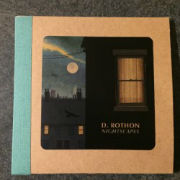
Home
|
D.ROTHON
- NIGHTSCAPES
DL/Vinyl Turquoise blue 500 copies on Clay Pipe wwwclaypipemusic.co.uk
David Rothon is a musician from south east London
who has been involved in a number of projects over
the years, from playing pedal steel guitar for the
likes of The See See, The Hanging Stars and he has
been an integral part of Redlands Palomino Co, to
a collaboration with Ian Masters of The Pale
Saints and Cloudier Skies with Claudia Barton.
Although he does play some pedal steel guitar on
this album it’s not really featured that
prominently. The record is informed by that period
in the middle of the night when insomnia takes
hold, when all around is sleeping, this is a
nocturnal journey into the hours before dusk and
dawn. With a palette of Mellotron, cor anglais,
Omnichord, strings and pedal steel, Nightscapes is
an otherworldly ambient record, which in keeping
with most of the fine records from Clay Pipe, is
also informed by field recordings. The record
really works best when listened to as a whole,
with each track complimenting one another
throughout. The album starts with peels of ambient
pedal steel introducing ‘The Midnight Bell/I Have
Been Here Before’. This is swiftly joined by
ghostly narration and Omnichord. ‘And Breathe’ is
a heavenly trip into exotica, highly melodic with
some faintly disturbing electronic percussion.
‘Waldeinsamkeit’ is a highly evocative tune, it’s
like some distantly remembered TV theme, delivered
via cor anglais, guitar and strings. ‘The Bus That
Never Came, The Train That Never Left’ is full of
crepuscular Mellotron, cloaking the track, adding
barely there percussion and swirling strings, to a
tune that is reminiscent of a woozy ‘All Of Me’.
‘Lonesome Depot’ a verdant, dripping, ghostly
tune, redolent with plangent peels of steel and
electronics, it’s lonesome, cold and wet. ‘The
years That Fall Away’ sees piano, vibes, keyboards
and percussion, creating another wonderful slice
of off kilter exotica. ‘In These Quiet Streets’
pacing footsteps of unfulfilled sleep, to a tune
delivered via cor anglais, keys and ambience is
again quite cinematic. ‘Straight On Till Morning’
briefly highlights his pedal steel, but quickly
yields to a tune of woozy Mellotron, Omnichord and
sparse percussion. ‘Unwoken City’ gradually
coalesces into a drifting, dreamy piece of ambient
music; a wash of otherworldly sounds envelops the
listener, dragging them down into sleep. The
record ends with ‘Mello Toning’ a melodic tune of
Mellotron, pedal steel, keyboards, and gentle
percussion. Another winner from Clay Pipe, it’s
not released until early in December, but I am
reviewing it early to give you all the chance of
getting a copy before it inevitably sells out.
(Andrew Young)
|
| |
|
|

Home
|
KINSKI –
ACCUSTOMED TO YOUR FACE
(Kill Rock Stars www.kinskiseattle.bandcamp.com
)
Seattle band Kinski are now approaching their
twentieth year as a band and return with their
fourteenth long player, having been on Sub Pop for
most of the noughties and Kill Rock Stars for most
of this decade. Along the way they also recorded a
few 7” for labels such as The great pop
Supplement, Trensmat and God Unknown among others,
and appeared at several Terrastock festivals
having been invited by Phil, who remains a big fan
of theirs. They have also collaborated with Acid
Mothers Temple and released split singles with
Bardo Pond and more recently with Kikagaku Moyo.
The record starts with the knowing ‘Fun Couple’
before the short sharp punch of ‘Guest Girl
Vocalist’. ‘Kinski 101’ is an instrumental blast
of chugging, angular rock, with a couple of short
succinct guitar solos. ‘This Is the Weekend We
Take the House Apart’ is pure classic indie rock,
almost catchy, imbued with some molten lead guitar
breaks in a couple of places. ‘There Goes Hot
Stamper’ is another fairly short, but heavy,
fuzztastic punk-rock song. ‘Riff MOM’ is more
instrumental riff laden indie rock. Things then
settle down a bit, for the seven plus minute
instrumental song ‘A Nap Is a Slice of the World’,
more layers of rhythmic guitars, bass and drums
locking together as one, weaving cool patterns.
The record ends with ‘That’s the Way I See the
City’ providing a nice instrumental conclusion to
the album, which has been produced by Trans Am’s
Phil Manly, a song on which he plays Ebow and
tremolo guitar. It also has a little bit of muted
trumpet played by Greg Kelley.
(Andrew Young)
|
| |
|
|

Home
|
KEIRON
PHELAN – PEACE SIGNS
(Gare du Nord CD/DL www.
garedunordrecords.co.uk )
Keiron has quite a lengthy recording career,
recording albums for the likes of Rocket Girl,
Leaf, Static Caravan, Rural Colours and Second
Language to name a few. He was a member of State
Widening River and Littlebow, was one half of
Phelan Sheppard, and more recently has produced a
couple of albums as a principle member of Anglo
Japanese outfit Smile Down Upon Us. As far as I
can see most of these projects have been
instrumental, Moom Looo was the main vocalist in
Smile Down Upon Us, so it was a big surprise to
find out that on this album Keiron has for all
intents and purposes produced a singer songwriter
album, and what a fantastic album it is. Full of
humour and excellent musicianship, Keiron has
surrounded himself with some of the cream of
London’s players, It was recorded at Soup studios
by Giles Barnett and Simon Trought.
‘New Swedish Fiction’ introduces the album,
Keiron’s voice reminds me a little of Edwyn
Collins, the song is enlivened by his flute
playing and by some beautiful harp played by Brona
McVittie. The title track ‘Peace Signs’ features,
as do most of the songs, the fine piano of Jenny
Brand, sympathetic drums by Ian Button, and bass
by co-producer Giles Barrett. It also has a touch
of violin by Jack Hayter. ‘Satellite Hitori’ up
next sounds like the stuff he came up with in
Smile Down Upon Us, a jaunty, sprightly song, its
lyrics speak of a truculent, uncommunicative
satellite, it has organ by James Stringer, a touch
of Oscilator by Oliver Cherer and more lovely
harp. Most of the songs feature Keiron’s fine
flute playing. ‘Song For Ziggy’ features clarinet
by Jenny Brand and whistling from Simon Trought,
it’s an infectious song, as light as a soufflé,
Jack Hayter adds some pedal steel and the whole
thing is just delightful.
‘Mother To Daughter Poem’ features vocals by
Angele David-Guilou, and some interesting
percussion by David Sheppard, more harp,
whistling, clarinet and organ.
‘Apple Shades’ is a wistful chamber/folk song,
with oodles of clavinet and clarinet swirling
around each other. ‘My Children Just The Same’ ups
the tempo, it also features a pretty violin
refrain. ‘Ain’t She Grown?’ is a beautiful folk
rock song about how quickly time has flown by, it
also has some fine pedal steel guitar, stately
piano and is pretty much perfect. ‘Country Song’
almost instrumental, is a fine, pastoral tune, all
the instruments given room to shine, particularly
flute, harp and pedal steel. ’Hippy Priest’ is a
knowing, humour filled song, it has some great
lyrics, taking in along the way, The Piltdown Man,
Desperate Dan, The Klu Klux Klan and Telegram Sam.
This staggeringly good record ends with
‘Canterbury’ a Chauceresque mystical song, with
all the musicians complimenting each other
throughout. It is without doubt, one of the finest
albums that I’ve heard this year and I’ve heard
quite a few.
(Andrew Young)
|
| |
|
|
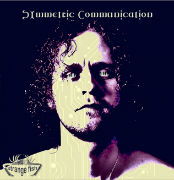
Home
|
KRIS
GIETKOWSKI – SYMMETRIC COMMUNICATION
(LP/CD on Strange
Fish Records)
Polish multi-instrumentalist Kris Gietkowski was
rescued from YouTube obscurity by Fruits de Mer
Records when a smitten Keith Jones chanced upon
his solo interpretations of tracks from the 1970
debut album by Egg. A very fine album of Egg
material followed on the Fruits de Mer ‘Strange
Fish’ imprint with a further limited run release
where the material covered expanded to embrace
Atomic Rooster and The Crazy World of Arthur
Brown. That’s perhaps not a career path embraced
by many except the very brave but the results so
far are very definitely worth the risk.
‘Symmetric Communication’ breaks the mould by
including original compositions alongside a cover
of Egg’s ‘A Visit To Newport Hospital’ (from their
second album ‘The Polite Force’) on a 3 track
vinyl release, expanded to 4 tracks on CD. In the
good old ‘prog rock’ tradition the four tracks on
this release are not concise with the shortest
track clocking in at over 8 minutes but they
provide the space for some imaginative and diverse
instrumental adventures which come together in a
cohesive and well put together set. This is
predominantly a keyboard driven record but that’s
not to underplay Kris’s general skills on other
instruments and like other one man bands such as
Todd Rundgren for example, he plays the entire
supporting cast more than adequately.
The record starts with F(x), an almost 20 minute
three part suite that in many ways defines the
scope and ambition of the album. This is a record
grounded in well chosen classic progressive
influences but also more modern references. The
former is found in the spiralling repetitions,
dramatic riffs and complex time signatures
defining Van Der Graaf Generator and the
classically influenced organ sound of early ELP
blending skilfully with Canterbury vibes and
touches of pastoral psychedelia and even hints of
jazz fusion and church music. There are also
enjoyable moments of what can I can only describe
as ‘electro-psych’ or ‘lounge prog’ which would
not be out of place on Stereolab or High Llamas
records. The aforementioned Egg cover and ‘Divided
By Zero’, another original composition complete
the vinyl release (with bonus track ‘I’m Afraid I
Can’t Do That Dave’ on the CD version) and they
perfectly complement the theme set by the opening
track i.e. changing time signatures, memorable
riffs and elegant melodies skilfully brought
together in long form tracks that don’t outstay
their welcome.
Kris’s skill on this record is to imbue a real
sense of respect for his influences whilst
avoiding simple pastiche, clearly having fun and
adding his own musical personality to the mix.
It’s part mad professor but also an intelligent,
complex and yet melodic record that successfully
straddles musical generations and the result is a
really enjoyable listen. Seek this out and enjoy a
time warp with a modern twist.
(Francis Comyn)
|
| |
|
|
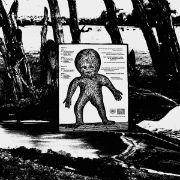
Home
|
DEAD SEA
APES & ADAM STONE – WARHEADS
(LP/CD on Cardinal
Fuzz Records)
When I heard that Dead Sea Apes were going to
release a collaborative album with writer and
artist Adam Stone I was certainly curious about
how that might sound. ‘Warheads’ certainly paints
a bleak, downbeat, sometimes angry and often
dystopian picture of the world through the eyes
and words of Adam Stone but not without a fertile
imagination and a dry deadpan wit which comes
through in the lyrics and monologues that Dead Sea
Apes provide a fascinating and effective
soundtrack to.
‘Inside of Me’ kicks off the record in grand
style with a picked guitar melody drenched in
sixties pysch surf and TV thriller atmosphere that
paves the way for a short and punchy garage punk
song with Adam Stone’s John Lydon/Jello Biafra
like vocal generating an added boost of urgency
and edge. ‘Reduced to Zero’ follows and at almost
11 minutes in length is very much like a variation
on The Doors more out there versions of ‘The End’.
It performs a sharp U-turn in musical and vocal
style starting as a slow building spacey eastern
tinged psychedelia with atmospheric percussion,
guitars and drones over which the almost spoken
vocals slowly grow in passion and intensity to an
echo drenched shout matched perfectly by the
swelling energy and emotion of the guitar and
drums. It’s a quite spectacular track that is
followed by another lengthy epic in ‘Retreat To
Your Bunker’ which has an insistent electronic
almost industrial groove, driving repetitive beat
and nagging vocal that could easily come from The
Fall’s top drawer. If Mark E. Smith and Robert
Calvert sat down over a pint or three to chat
about the state of the universe it might well
sound something like these long but captivating
tracks which may not contain much in the way of
sunshine and joy but nonetheless are good for the
soul. ‘(You Are) Doing What You Want (All Of The
Time)’ returns to a heavier garage rock sound with
a psychedelic edge and with the howling
Lydon/Biafra vocal reappearing to great effect.
‘Broken In Two’ is different again with electronic
pulses and waves of synth and guitar bringing a
new soundscape to the record that once again
provides a great match for Adam Stone’s intense
and bleak observations. ‘Yes/No’ is powered by a
heavy and doom laden riff that has touches of
shoegaze and grunge guitar from the nineties with
a distinctly metallic edge. The final track ‘Power
To The People’ again starts out with electronic
pulses and waves of guitar and synths over which
an incredibly John Cooper Clarke like vocal
dispenses a final serving of finely tuned
pessimism and weary wisdom.
I really like this record and its diversity of
musical styles and influences which make what
could have been a difficult and awkward record
very listenable, often gripping and definitely
accessible. It’s a great addition to the Dead Sea
Apes canon albeit one which was unexpected.
Pessimism and grim reality can be entertaining and
here’s a masterclass in how to do it.
(Francis Comyn)
|
| |
|
|

Home
|
ISRAEL
NASH - LIFTED
(LP/CD/DL on Loose
Music)
Israel Nash’s fifth album came out mid-summer and
I’ve had it on repeat ever since. “File Under
Hippie Spiritual” says a tiny note on the cover.
Hmmm. Operating out of a sprawling ranch in
Dripping Springs, Texas, Nash embodies Lifted with
glorious melodies and musical grandeur on an epic
scale, but there’s one thing that ultimately pulls
me in more than anything else: It has a Big. Fat.
Lush. Honkin’. Shiny. 1970s Production that you
just don’t hear any more.
To say Nash piles layers of instruments and
voices high and applies a liberal dose of reverb
throughout is a bit like saying dogs slightly like
to ride in cars with the windows rolled down. The
songs evoke widescreen imaginings of vistas of
rolling hills, gushing rivers, desert prairies and
big skies, bigger than all get out. The melodies
are deceptively simple, the kind you take to the
moment the song starts. He writes of nature,
individuality and imbues his songs with a strong
sense of pathos.
The blend of his unique voice and the wall of
sound kind of makes me think somewhat of Gregg
Allman fronting 'All Things Must Pass'. Indeed,
Nash name checks All Things Must Pass on “Strong
Was the Night,” whose melody also reminds me a
little of the Allmans’ “Sweet Melissa.” Other
influences you’ll hear are Neil Young, Jonathan
Wilson, and a dash of Brian Wilson circa ‘66. But
oh, that production. The analogue sound soars
from the Texas prairie to Laurel Canyon and back.
Co-producer and engineer Ted Young deserves all
kinds of credit, as do musicians Joey McClellan
(guitar), Aaron McClellan (bass), Eric Swanson
(pedal steel), and Josh Gleishmann (drums), plus
Jesse Chandler (arrangements), members of Grupo
Fantasma (horns), and Kelsey Wilson and Sadie Wolf
(strings).
Choosing highlights is next to impossible here;
there are just too many. “Looking Glass,”
“SpiritFalls,” “Northwest Stars (Out of Tacoma),”
“Hillsides,” “The Widow,” and the aforementioned
“Strong Was the Night” are all out of this world,
widescreen cinematic paeans to greats past and the
present, and a world of possibilities.
'Lifted' is my #1 album of the year. Masterful.
Go out and get ya some.
(Mark Feingold)
|
| |
|

Home |
ENVIRONMENTS,
VOLS.
1-11
(DL,
App on Numero
Group)
Between
1969 and 1979 a unique
mastermind named Irv Teibel single-handedly
recorded, produced and issued 11
albums of natural sounds.
The albums
sold millions to a stressed-out world.
Part artist, part sound engineer, and
part huckster, Teibel started an
industry that continues to this day in a
multitude of forms.
When our family used to travel with our
then-small
children, we brought a white noise machine that
simulated sounds of the surf,
or rainfall, to help them fall asleep.
That’s Teibel’s legacy.
Whether it’s
cassettes in a gift shop, humpback whale
recordings, waterfall machines in
catalogues, dentist’s offices – you name it –
Teibel knew he had something back
in the late 60s and it continues to this day.
The original environments albums were and
still are the best of the
genre. They
sold millions back in the
day. But
after being long out of print,
the albums have all been re-released.
You can find them on the major streaming
services, and Numero Group has
even created an app where you can mix and match
things like “The
Psychologically Ultimate Seashore” and “Ultimate
Thunderstorm.”
I
say they’re the best because
Teibel painstakingly recorded his found sounds,
then meticulously processed and
mixed them for effect, essentially dialing them
up to 11. I
must say they sound remarkable.
In
1968 Irv Teibel went to Coney
Island on assignment to record the sound of the
surf for a film soundtrack with
an Uher portable stereo reel-to-reel and an
assortment of microphones and
cables. He
found the results
captivating. However,
he wasn’t
satisfied the with the overall result.
A
friend later turned him on to one Hermann Ludwig
Ferdinand von Helmholtz, a 19th
century German physician and physicist, who
believed that the sounds of nature
such as the wind and the sea “might have great
psychological benefits, if only
some means of accurate reproduction could be
found.” Teibel
would spend the next year traveling up
and down the eastern seaboard, making 100
recordings of the sea, none of which
satisfied him. He
took his original
Coney Island recording to a friend named Louis
Gerstman, who worked at Bell
Labs, and had access to an IBM 360 computer, an
astonishing piece of hardware
in 1968. Working
together for days,
running the recording through the computer,
making tweaks and adjustments, and
adding delays and overdubs, Voila, they produced
Teibel’s “Psychologically
Ultimate Seashore,” to be released in 1969 as
Side 1 of environments 1.
Side 2 would be recorded in the Bronx
Zoo,
called “Optimum Aviary.”
The album was
an immediate hit.
An industry was born.
Teibel
would garnish his record
sleeves and press releases with claims such as
“HAVEN’T FELT SO GOOD SINCE MY
VACATION, BETTER THAN A TRANQUILIZER,” as well
as boasts that the series would
improve reading speed and comprehension, improve
appetites, make hypertension
vanish, improve students’ grades, and noted that
the “effect on the esthetics
of lovemaking is truly remarkable.”
Subsequent
releases would
include titles like “Gentle Rain in a Pine
Forest,” “Wind in the Trees,” “Dawn
in the Okefenokee Swamp,” (where fortunately
Teibel’s Scottish Terrier was
trained enough to not howl when threatened by an
alligator), “Summer
Cornfield,” “Caribbean Lagoon,” “English
Meadow,” and “Alpine Blizzard.”
Teibel
would advance in technological
sophistication with the times as well.
For “Wood-Masted Sailboat,” (environments
8, 1974), he filled 24 tracks,
including seagulls from the Virginia shore, bell
buoys from the Long Island
Sound, a creaking mast, and an old chronometer
from a clock shop in Manhattan.
So
how does it all sound?
Incredible, I think.
I thought that it would be like watching,
er,
listening to paint dry, or “Furniture Music” in
the words of Erik Satie.
But when I took it out for a drive about
town, with four speakers emanating
hyper-waterfalls, crickets, seashores, and
thunderstorms in surround sound, I found it to
be the most relaxing drive of my
life! The
sounds are at once alive and
vibrant, and you’re right there in the middle of
it all. It’s
definitely not wallpaper to forget in
the background.
As
for how to listen to it, you
can do it any way you like, but since most of
the tracks are at least 30
minutes, my preference is to use the streaming
service or the app to create a
playlist. Then
you can advance the track
in less than the full duration to another one.
You can arrange it by the hours of the
day, or shift back and forth
between the various water-based tracks and
land-based ones.
It’s your thing, do what you want to do,
as
the Isely Brothers said.
(And I can’t
tell you who to sock it to – just had to get
that in).
Ironically,
Irv Teibel went out
into the middle of nature with his microphone so
you could shut the world out,
and it works. The
environments series is
like nature in audio High Definition.
You may want to jump in that ocean or
grab an umbrella in that
thunderstorm.
(Mark Feingold)
|
|
|

Home |
SHOOTING GUNS – NOSFERATU
(LP/CD on Cardinal Fuzz Records)
Shooting Guns are more usually associated with intense and heavy riffs, pulverising psych and kosmische inflected jams which go for the jugular and keep a firm grip right to the end. A score for FW Murnau’s silent classic ‘Nosferatu’ was perhaps not something I would have expected to hear but actually on reflection it was perhaps inevitable that Shooting Guns would take their ability to create tense and thrilling music in a different direction.
‘Nosferatu’ was recorded live at the Roxy Theatre in Saskatoon and is a little over 70 minutes in length. Whilst it would be great to have the film playing alongside this music it is by no means essential as Shooting Guns have created a soundtrack that, from the opening doomy pulses, drips with atmosphere and cinematic quality, transporting the listener to an eerie place and all the brooding, sinister tension that lies in the Nosferatu story.
The soundtrack initially relies on the combination of drones, pulses and sparsely strummed and plucked guitar to create the underlying atmosphere but within the brooding menace and mystery there are short interludes of beauty such as delicate acoustic guitar and keyboard melodies which shine an occasional ray of light through the gloom. As the soundtrack progresses the introduction of drums, more prominent swirling organ and synths and occasional bursts of heavier guitar riffs brings a stormier feel to proceedings but again there is light and shade with interludes of lonely, mournful strings, organ drones, sparse electric piano, shimmering percussion and spacey guitar and effects that convey and maintain suspense and storyline wonderfully well for the real and imagined film. The closing section of the soundtrack explodes the building tension into life when it breaks out into a driving heavy psych riff based finale with the simple repeating melody that runs through the piece cutting through the squalls of guitar and drums until a gentle electric piano and percussion based fade.
This is a wonderfully imaginative soundtrack which is more than good enough to stand alone as a very listenable record in its own right. It’s rich in imagery and you could happily shut your eyes and create your own mental film to this soundtrack but I would suggest trying it with the FW Murnau film too if you can.
(Francis Comyn) |
| |
|
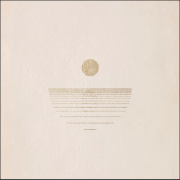
Home |
MT. MOUNTAIN – GOLDEN RISE
(LP/CD on Cardinal Fuzz Records)
‘Golden Rise’ is the third album from Perth, Australia’s Mt. Mountain. I’ve been very impressed by the previous recordings and ‘Golden Rise’ continues to build, evolve and refine the Mt. Mountain sound with some fine song craft on display.
‘Cathedral’ is the six minute opening track and starts with a woozy guitar and urgent, swinging beat. A lovely melodic vocal and a touch of psych pop meets electric folk in the sound makes for a fine tune that makes me think of both The Stone Roses and Fairport Convention which I can honestly say doesn’t happen very often. ‘Oculus’ follows and is based on a slower, heavier groove with waves of pulsating guitar and airy vocals gently washing over a hard hitting rhythm and occasional flourishes of spacey guitar and heavier riffing. ‘Acceleration’ starts in a quiet shuffling Tindersticks style before once more introducing a dreamy wah wah guitar over a gently swinging beat with a slightly new wave-ish almost emotionless and detached vocal which after a while ebbs and flows on flurries of cymbals and washes of guitar. ‘Shadow Walk’ is an instrumental track with a punchy beat and is a starker affair than previous tracks. It slowly ramps up the tension with the guitar and drums building a very tight rhythmic riff after which a more minimal spacey feel and laid back groove takes over.
‘Open Door’ is gorgeous and takes the album in a new direction with some clear post rock influences from the likes of Tortoise and Mogwai in the sparse rhythm and skeletal picked and strummed guitar which nonetheless deliver striking and engaging melodies. There’s a lovely flute melody weaving through the song which gives it an almost pastoral quality. Vocally I’m actually reminded of bands such as The Beta Band with its gentle dreamy folk/psych and almost hymnal or choral stylings. ‘Interceptor’ follows and initially shares a similar post rock feel with the vocal once more introducing a slightly folky, psych/indie melodic quality before a lovely, gently spacey and yet intense guitar solo builds slowly to the finale. The title track ‘Golden Rise’ continues the spacey, post rock feel with a vocal that has a kind of incantation or nursery rhyme quality. The song has some lovely guitar playing that has hints of David Gilmour in its waves of sparse, slowly strummed and picked beauty and it creates a lovely shimmering, hazy hypnotic groove which feels way too short at just over five minutes. I imagine this will be a beautiful extended thing when played live.
‘Alectrona’ is an instrumental track and it changes the feel of the album with more prominent almost ritualistic drums and a heavier repeating guitar melody that leads nicely into ‘Sun Sloom’ which sways along with a gentle, dreamy, folk influenced vocal over a jangly guitar melody that swells nicely into waves of woozy, almost shoegazey perfection. ‘No Return’ is the final track on the album and is a gently brooding, atmospheric slow burner that keeps building up the tension and energy. It never explodes into the half expected roar of sound but instead gently and rather beautifully fades to nothing. It’s a lovely ending to a fine record.
This is a record which has a great deal of continuity of sound and feel but rather than sounding very samey and one dimensional it has a subtlety in its dynamics which gives it an almost hypnotic quality and there are some gorgeous dreamy songs and instrumental passages to enjoy. I love the blend of post rock ‘light and shade’ dynamics with the psych, folk and pastoral melodic sense and touch of indie urgency which runs through this record. ‘Golden Rise’ is the sound of a band confident in their sound and happily exploring its nooks and crannies. I get the impression that Mt. Mountain live will use these tracks as a springboard for some pretty wild journeys and I for one can’t wait to see them play. Highly recommended.
(Francis Comyn) |
|
|

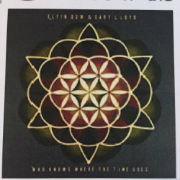
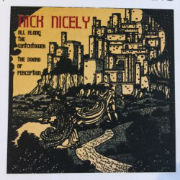
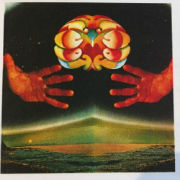
Home |
THE CHEMISTRY SET - FIREFLY B/W SAIL AWAY
ELFIN BOW AND GARY LLOYD - WHO KNOWS WHERE THE TIME GOES B/W THE WISDOM
NICK NICELY - ALL ALONG THE WATCHTOWER B/W THE DOORS OF PERCEPTION
TOUCH - WE FEEL FINE B/W DOWN AT CIRCE’S PLACE + WE FINALLY MET TODAY
(www.fruitsdemerrecords.com)
Four new limited edition coloured vinyl 7” singles have just arrived from Fruits de Mer records. This latest batch of singles, provide the icing on the cake, for what has been a splendid year for the label.
Firstly, we have a new release by The Chemistry Set, a band currently celebrating their 30th anniversary. “Firefly” is way up there with the finest things that they have made, a classic from a band that are for me one of the finest psychedelic bands to have come out of England in the last thirty years. It starts with a huge Arabesque motif, bursting out of the speakers, dirty organ, fuzz guitar, bass and drums, all tight as a nut. It is a terrific, pulsating tune, with ethereal vocals, a great little succinct guitar solo, and a ton of phasing on the outro. “Sail Away” is ushered in with slide guitar and tabla, a lilting song of escaping to distant islands, it also features 12 string, a searing guitar solo, a touch of echo with a little mellotron towards the end, magnificent stuff indeed. It also comes with a bonus CD with their version of the Moody Blues song ‘Legend of a Mind’, remixed by Astralasia’s Mark Swordfish and running to over twenty minutes.
Art teacher Elizabeth Kearney aka Elfin Bow is possessed with a beautiful voice and here on this single has achieved a long -held ambition to record with an orchestra. The Scottish Session Orchestra; made up of members of the finest Scottish orchestras. A thing of beauty, this single is produced by Gary Lloyd. Fruits de Mer’s Keith has often said that Sandy Denny is his favourite female singer and Elizabeth gets to tackle one of Sandy’s finest. Her version of “Who Knows Where the Time Goes” is achingly gorgeous, her voice is simply sublime, the instrumentation of the band framing the song sympathetically, with the orchestra sprinkling their magic all over the song as it progresses. What a cracking version. “The Wisdom” is a reworked version of a song appearing on her debut solo album. It shows what a fine songwriter she is, an ethereal ballad about finding your voice in the world and in the confidence that produces. That pure untrammelled voice and her delicate acoustic guitar picking out the song’s melody, a cello provides a deep anchor, and then the strings arrive, the song swells, ending with a hint of brass. Top marks, a truly wonderful pair of songs.
Nick Nicely originally created this piece for one of Sendelica/ Fruits de Mer festivals in Germany; he didn’t make it in the end but decided to utilize the backing tracks that he had created. “All Along the Watchtower” will need no introduction, being as it is a classic Dylan song which has been recorded by numerous acts such as Hendrix, Spirit, etc, down the years. Nick takes the song somewhere else; it arrives on a foggy bed of Mellotron, stinging waspish lead guitar, found sounds, seagulls, drum and bass, spoken treated vocals, and backwards guitars. “The Doors of Perception” is of a similar construct in its instrumentation. Utilizing tapes, found sounds, vocals and guitar, it’s well constructed and dense, the effect is quite psychedelic, running to almost six minutes; it ebbs and flows, again with that spiky waspish compressed lead guitar.
Touch is the very first reissue single by the label. A long-time favourite record of Keith’s who used to doodle the Touch logo all over his schoolbooks, ah bless! It is truly as mad as a box of frogs. The Touch album was released by London/Deram in 1969 and bombed. “We Feel Fine” is all over the place mad swirling organs, bombastic vocals, clattering drums and lead guitar. It’s like we have suddenly arrived in the middle of some bizarre musical. Heavy, quasi classical rock spewing out all over the place, It’s like some strange mix of Atomic Rooster, Hair and the Bee Gees. “Down at Circe’s Place” is all strident piano, drums, percussion, synths. Eventually something resembling a song appears, replete with ghostly, falsetto vocals, before it falls away to a lead guitar and organ jam. “We Finally Met Today” is an unreleased song from 1968 and it positively reeks of the sixties, it’s not quite as mad as the previous two songs, but it shows a band well on their way, even having a false ending. This single is 33 rpm and comes with a mini replica poster.
(Andrew Young) |
| |
|
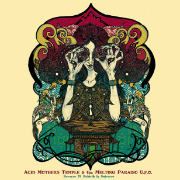
Home |
ACID MOTHERS TEMPLE & THE MELTING PARAISO UFO – REVERSE OF REBIRTH BY UNIVERSE
(LP/CD from www.riotseason.com)
Having long since given up trying to keep pace with their recorded output (over 100 albums now in various manifestations) it’s still gratifying to know that Acid Mothers Temple – three little words that warm the ventricular cockles of any fan of Japanese underground music - continue to dish the Dijon go from strength to strength. And while the Next Generation (Kikagaku Moyo, Minami Deutsche etc) are quite rightly feted there’s no doubt who still sets the benchmark from modern psychedelicists from Out East.
Based for the best part of a quarter of a century now around the solid nucleus of Higashi Hiroshi and Kawabata Makoto, AMT have tended to shed and replace their other members like so much snake skin. Any thoughts that this latest version of the band in any way represents a dilution of the brand need to be banished forthwith, mind. Back on Riot Season for the first time since the IAO Chant From The Melting Paraiso Underground Freak Out - they never knowingly undersell themselves when it comes to titles or for that matter album covers https://bit.ly/2Ks5f8r - a lot of the material, or at least a couple of titles here may be familiar to hardcore initiates. It’s just that it has all been intensively reworked to the extent that they are now more likely to be on nodding terms than being able to claim intimacy with the originals and with which they stand comparison.
Classifying the opening minutes of ‘Dark Star Blues’ as “folk rock” isn’t as weird as it sounds, believe me. The first time your bumble scribe came across AMT was at one of the Feed Your Head events at Royal Festival Hall in 2001, a series of gigs that pre-empted by what seems like light years the more recent psych revival and where AMT relied as much on folk drone as on their trademark cosmic inferno. New recruit Jyonson Tsu finds plenty of room for expression, his vocal a wisp of a whisper at times, the instrumentation relatively sparse and exotic sounding (bouzouki? Surely not). Mind, you’d be advised to seek counselling were you to consider the second half to be in any tradition other than righteous interstellar overdrive. Incendiary drummer Satoshima Nani fills the gaps before some dense riffing provides the foundation for Kawabata’s guitar-as-flamethrower party piece. Still it refrains from pushing all the phasers up to max on the mixing desk. Phasers on stun it is, then. Or, as my bank manager would say, stay out of the red.
From here on in, it gets…longer. At 12 minutes, ‘Blue Velvet Blues’ is marginally more expansive than the original from 2002 and somewhat less cavernous of sound. That said, those who love having their synapses seared by solar flare guitars will not be disappointed during the first segment. It then subsides into celestial reflection, as Tsu’s gossamer vocals again adds a delicate strangeness supplemented by some Hiroshi synth bleeps. Space drips and spacesuit trouser rippers? We can’t get enough of them I can tell you.
Download codes don’t do flipsides but this is where impeccable logic and some rare attention to the promo sheet comes in handy. Having dispensed with the remake/remodels, ‘Black Summer Song’ shows that AMT can still build from the ground. A jarring cacophony, almost free jazz, launches into a marathon astral voyage hurled into hyperspace by the constantly building fast cadence of the extraordinary Nani’s assault and batteur-y and Kawabata edge of the seat guitar, eventually subsiding into a distant discordance of old medium wave radio signal as if emanating from a distant planet.
Well hold that last thought. Those of you who don’t consider CDs either too weird or else heretical will be treated to the bonus track and it’s another oldie albeit not one of theirs but ‘Flying Teapot’ by AMT’s venerable old compadres Gong. This was a staple of their 2017 tour (and yep, still kicking myself and anything else in range for having managed to miss this autumn’s dates) and shows why they made such easy bedfellows for Daevid Allen and Gilli Smyth during the Acid Mothers Gong iteration. This rendition is nothing short of extraordinary, powered by fast and funky bass lines bobbing across vast oceans of glissando and what seems like a whole galaxy of sky in which to improvise. Of course it all hurtles into the excess wig-out area in an orgiastic burn-up prior to the joyous rousing “high in the sky, what do you see…” payoff (come now, you all know the words). Listen carefully and you’ll spot a cheeky lift of a certain Steve Hillage solo run, too. A real bag of tricks and treats then and while it may lack a little the subtlety of the original, for an ecstatic high octane buzz right now this one’ll take some shifting from the playlist.
(Ian Fraser) |
| |
|
| |
|
| |
|
|
 |
|

